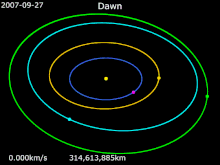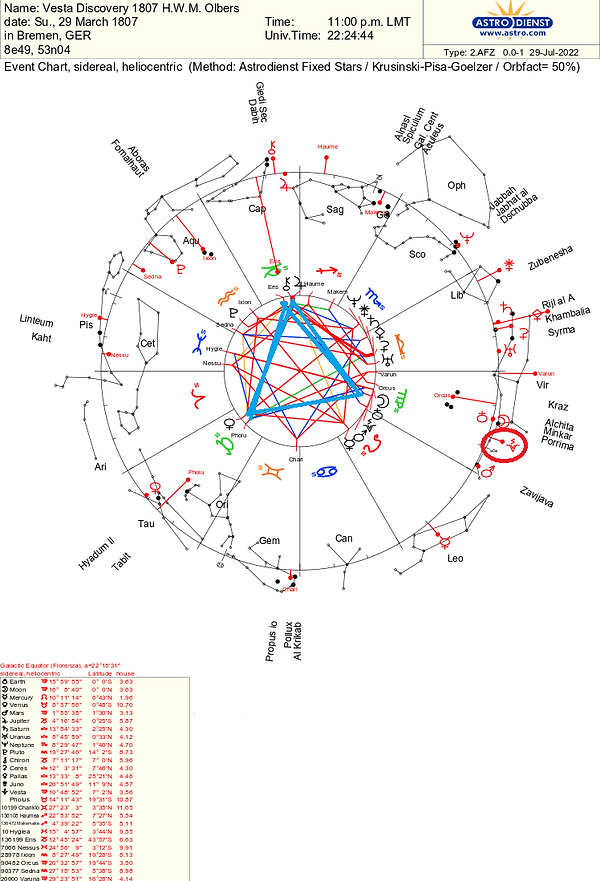Vesta - "The eternal Flame"
Astrology:
Vesta represent the inner, sacred flame - what we really "burn" for, in the meaning of purpose. She's about DEVOTION, commitment, sacrifice and service. She can also be about transforming sexual energy to a "higher calling" - or liberating the sexual energies within self.
Committing to the spiritual path and galactic or universal connections.
Greek Mythology:
Hestia is the firstborn child of Cronus and Rhea. She's as her later Roman counterpart the goddess of the eternal fire, the hearth. Poseidon (Neptune) and Apollo were fighting for her hand but she refused and stayed unmarried for all her life. In Greek tradition the "leading woman" in a household was responsible on getting the hearth fire burning. In Government buildings it was an Official and it was the first ritual to be hold, when a new city or village was developed.
It's interesting to note that in ancient times, it was believed that the inside of Earth was kind of a fire and the same would be true for the "center of the Universe"... so a truly spiritual path here...
Roman Mythology:
Vesta the Goddess of hearth, home and family. She was a daughter of Saturn and Ops, therefore Sister of Jupiter, Neptune, Pluto , Juno and Ceres. Her Priestesses were called the "Vestal Virgins" and watched over the "eternal flame". Vesta didn't get involved with any of the stories of the other gods and goddesses. Cicero states it explicitly. The purity of the flames symbolized the vital force that is the root of the life of the community.
Vesta is a Virgin-Goddess and it's said that the mother of Romulus and Remus (building of Rome) was a Vestal-Virgin giving birth to the Son of Mars...
Some Astronomy:
Vesta is the second-largest asteroid, both by mass and by volume, after the dwarf planet Ceres. It constitutes an estimated 9% of the mass of the asteroid belt. Vesta orbits the Sun between Mars and Jupiter, within the asteroid belt, with a period of 3.6 Earth years, specifically in the inner asteroid belt, interior to the Kirkwood gap at 2.50 AU. Its orbit is moderately inclined (i = 7.1°, compared to 7° for Mercury and 17° for Pluto) and moderately eccentric (e = 0.09, about the same as for Mars). Vesta's rotation is relatively fast for an asteroid (5.342 h) and prograde, with the north pole pointing in the direction of right ascension 20 h 32 min, declination +48° (in the constellation Cygnus) with an uncertainty of about 10°. This gives an axial tilt of 29°. (Ref. Wikipedia)

Credit: NASA Dawn spacecraft

Animation of Dawn's trajectory from 27 September 2007 to 5 October 2018 Dawn = pink · Earth = blue · Mars = yellow · 4 Vesta = light blue · 1 Ceres = green
Credit: Wikipedia user Phoenix7777 (own work)
Vesta's orbital points
Vesta's journey around the Sun - the "cross" that forms in the sense from the two points of crossing the ecliptic and the most southern and northern parts of orbit....
Southnode
When we calculate a chart of Vesta, at her moment of crossing the ecliptic, she stands between the stars Ainalrami and Manubrium of Sagittarius. Ainalrami meaning "the eye of the Archer" and Manubrium marks the ear but translates from Arabic as "the handle". Manubrium is also the name of an important bone in the center of our breast, which got a hexagonal shape.
most southern point
Vesta travels from the 0 latitude of the Southnode to a latitude 7°8’18” south of the ecliptic in sidereal Pisces, just between the outlining stars of the constellations Pisces and Cetus. Vesta reaches that area in longitude of the star Linteum of Pisces - this star talks about covering and uncovering but also of "sheets, fabrics or fields".
Northnode
Vesta now ascended in orbit to the 0 degree latitude on the ecliptic, in longitude aligning with the star Mekbuda of Gemini. This star marks the leg of the immortal Twin Pollux. Mekbuda is a "pulsating" star with big variability in rate, which makes it appear in magnitude dimer or brighter... not to be confused with Pulsars though!!! …. Yet, where as Pulsars are great beacons of light, such a pulsating star as Mekbuda can still give us “advise” about of being "closer" or further away from the task in a "navigational" sense.
most northern point
Vesta's region of awareness within an orbit, resides at the "upper" outlining stars of Virgo. The closest star there is Auva, also called Minelauva, which is not as “sparkling” a star but that’s an “illusion” – the name comes from Arabic and refers to a moon mansion called “awwa”, which in turn is often referred to “barking”, dogs and dog kennels… In Chinese it refers to an asterism called the “left wall of supreme palace enclosure” and according to H.R. Allen to an asterism called “second Eastern Minister”… - back to the “illusion” – it’s a naked eye red giant but its light shines in mostly the infrared spectrum, which isn’t visible to the “human eye”. When including that light, Auva shines about 630 times as luminous as our Sun with a radius about 61 times that of the Sun.
Vesta Discovery
Vesta was discovered on 29th of March 1807 by the German Astronomer Heinrich W. M. Olbers. Geocentric location ca. 6 degrees 41 minutes sidereal Virgo and heliocentric ca. 10 degrees 48 minutes sid. Virgo - as Vesta was pretty north of the ecliptic, the geocentric chart shows close "conjunction" to the Virgo Cluster...
At that time her heliocentric nodal axis was at around 21 degrees Sagittarius - Gemini (therefore her most northern part of orbit in Virgo) and her Aphelion - Perihelion axis at 18 degrees Taurus - Scorpio...
On the 29th of March 1807, she stood in a heliocentric Grand Trine with - Venus in Taurus and Eris in Capricorn (to a lesser degree with Chiron in Capricorn)...
I find this a very interesting fact - a Grand Trine, triangle symbolizes trinity and with that is considered most "stable" and is in terms of platonic solids a symbol for "fire".
She's also connected in a sextile with Neptune at the Scorpion's head and him to the Jupiter-Chiron conjunction also in a sextile, which makes him and his themes to be part of this now not only GT but Kite.
To me this suggests to not only value that "inner fire" but to actively use it, apply it or to let it "rise" in order to master it all - it's kind of like "living it" instead of "holding it up" and maintaining it on an altar, like applied and lived devotion. Furthermore, it seems that dreams or "alternative / other realms" will contribute with experiences there and contribute to an expansion of consciousness and the breaking of "loops" or repetitive behavior.
